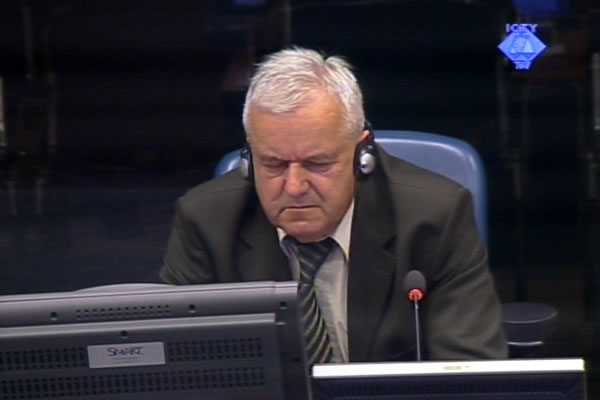Home
‘JOINT COMMISSION’: DID IT REALLY EXIST?
Karadzic’s defense claimed that a joint commission comprising the VRS and UNPROFOR visited a Serb mortar position on Mrkovici on 6 February 1994, a day after the Markale massacre. The joint commission purportedly concluded that fire had not been opened from that position. The prosecution contends that the commission ‘didn’t exist’; if it did, it only ‘served as a cover’
 Slavko Gengo, defence witness of Radovan Karadzic
Slavko Gengo, defence witness of Radovan Karadzic At the time of the first massacre at the Markale market on 5 February 1994, Slavko Gengo was the commander of the 7th Battalion in the 1st Romanija Brigade. The mortar positions at Mrkovici and Debelo Brdo were under Gengo’s command. According to the prosecution, on 5 February 1994, a mortar shell was fired from the direction of Mrkovici and hit the Markale market in Sarajevo; 66 persons were killed and more than 140 were wounded.
Karadzic read out the summary of the witness’s statement in court. On 5 February 1994, Gengo didn’t hear any mortar fire from the position on Mrkovici and didn’t receive any report about it, he said in his statement. The next morning, a joint commission comprising the representatives of UNPROFOR and the VRS Main Staff visited the positions, the witness claimed. The commission concluded that fire had not been opened from the positions. In his statement, the witness maintained that the VRS only returned fire and that it didn’t attack civilians. Muslims from Kosevo and the Jajce barracks often attacked positions held by his battalion, the witness said in his statement.
Prosecutor Fergal Gaynor put to the witness the prosecution’s case that the joint commission comprising the UN and the VRS representatives ‘never existed and if it did exist, it served as a cover’. In support of his claim, Gaynor showed several documents of the Sarajevo-Romanija Corps and UNPROFOR from the period immediately before and after the massacre. The reports don’t say a word about any commissions or inspections. The witness nevertheless stuck to his claim that the commission was there at the position, but couldn’t tell who the members were. Gengo’s assistant Milorad Dzida drafted the report about the visit, the witness said. In his evidence last week, Dzida said that a person by the name of Jakovljevic wrote the report.
The documents included the minutes from a meeting of UNPROFOR representatives and Colonel Cvetkovic on 13 February 1994. The UNPROFOR representatives asked the Serb side to give them a ‘technical confirmation’ that they didn’t fire the shell. Cvetkovic offered to take them to the locations they suspected the shell was fired from. The witness kept repeating that the commission visited Mrkovici but he didn’t know the exact dates. The witness was then shown a recording of a statement Karadzic made on 10 February 1994 in which he asked that an ‘international body’ come and investigate the incident that happened five days before at Markale, but the witness did not budge. He was not able to explain why Karadzic made this request if an ‘international body’ - the joint commission - had already visited Mrkovici.
Prosecutor Gaynor referred to Gengo’s claims that they never opened fire on civilian targets but that they returned fire, targeting Kosevo. Gaynor wanted to know what precautions were taken when inhabited areas were targeted. ‘They should have taken precautions because they knew we would respond to their fire’, the witness said. The witness added that he ‘couldn’t see’ if there were civilians near the sites from which fire was opened. The witness didn’t have anything to say about a document produced by the RS presidency, which states that the Serb forces were ‘not responding adequately’ to the attacks launched the Muslim side: they returned fire at a rate of ’20, 30 and even up to 70 times more’.
After Gengo, Karadzic called Stojan Dzina, who will continue his evidence tomorrow.
Linked Reports
- Case : Karadzic
- 2012-11-05 MOMIR CLAIMS HE’S ‘MOCALO’ NOT ‘MOMO’
- 2012-11-01 RESPONSIBILITY FOR MARKALE MASSACRE CONTESTED AGAIN
- 2012-10-31 CONTESTING THE RESULTS OF THE FIRST MARKALE MASSACRE INVESIGATION
- 2012-11-07 PEACE INITIATIVES AND ATTACKS IN RAJLOVAC
- 2012-11-07 KARADZIC’S WITNESS: ‘WE WERE CAUTIOUS’
- 2012-11-08 KARADZIC’S WITNESS: BOSNIAN GOVERNMENT KILLED PEOPLE IN SARAJEVO
